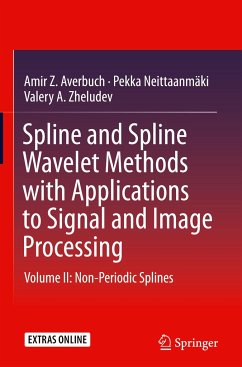This book presents various contributions of splines to signal and image processing from a unified perspective that is based on the Zak transform (ZT). It expands the methodology from periodic splines, which were presented in the first volume, to non-periodic splines. Together, these books provide a universal toolbox accompanied by MATLAB software for manipulating polynomial and discrete splines, spline-based wavelets, wavelet packets and wavelet frames for signal/ image processing applications.
In this volume, we see that the ZT provides an integral representation of discrete and polynomial splines, which, to some extent, is similar to Fourier integral. The authors explore elements of spline theory and design, and consider different types of polynomial and discrete splines. They describe applications of spline-based wavelets to data compression. These splines are useful for real-time signal processing and, in particular, real-time wavelet and frame transforms.
Further topics addressed in this volume include: "global" splines, such as interpolating, self-dual and smoothing, whose supports are infinite; the compactly supported quasi-interpolating and smoothing splines including quasi-interpolating splines on non-uniform grids; and cubic Hermite splines as a source for the design of multiwavelets and multiwavelet frames.
Readers from various disciplines including engineering, computer science and mathematical information technology will find the descriptions of algorithms, applications and software in this book especially useful.
In this volume, we see that the ZT provides an integral representation of discrete and polynomial splines, which, to some extent, is similar to Fourier integral. The authors explore elements of spline theory and design, and consider different types of polynomial and discrete splines. They describe applications of spline-based wavelets to data compression. These splines are useful for real-time signal processing and, in particular, real-time wavelet and frame transforms.
Further topics addressed in this volume include: "global" splines, such as interpolating, self-dual and smoothing, whose supports are infinite; the compactly supported quasi-interpolating and smoothing splines including quasi-interpolating splines on non-uniform grids; and cubic Hermite splines as a source for the design of multiwavelets and multiwavelet frames.
Readers from various disciplines including engineering, computer science and mathematical information technology will find the descriptions of algorithms, applications and software in this book especially useful.
"This book is the second volume in an extensive treatment of splines, spline wavelets, and their applications to signal and image processing. ... The book provides a self-contained and extensive exposition of the fundamentals of both splines and wavelets transforms ... . This book belongs on the shelf of every researcher in signal and image processing. ... a valuable supplement for graduate level courses." (James Stephan Walker, Mathematical Reviews, July, 2016)
"This excellent monograph provides a universal toolbox (with numerous MATLAB codes) for methods with polynomial resp. discrete splines and spline wavelets and corresponding applications in signal and image processing. ... This book is well-written and contains many examples and figures. It is very convenient for broad readership of graduate students and researchers in applied mathematics, computer science, physics, and engineering. Doubtless, this nice book will stimulate further applications of spline wavelet methods." (Manfred Tasche, zbMATH 1338.65032, 2016)
"This excellent monograph provides a universal toolbox (with numerous MATLAB codes) for methods with polynomial resp. discrete splines and spline wavelets and corresponding applications in signal and image processing. ... This book is well-written and contains many examples and figures. It is very convenient for broad readership of graduate students and researchers in applied mathematics, computer science, physics, and engineering. Doubtless, this nice book will stimulate further applications of spline wavelet methods." (Manfred Tasche, zbMATH 1338.65032, 2016)








